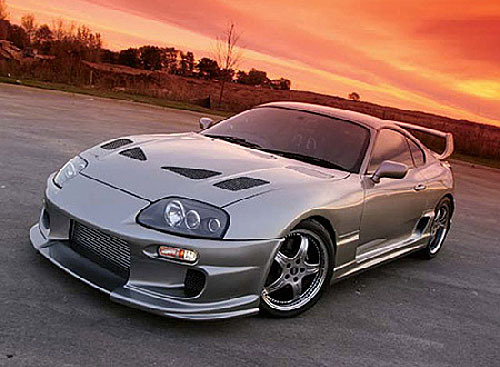New Car Review
 1998 Toyota Supra |
1998 TOYOTA SUPRA
by Tom Hagin
SPECIFICATIONS
Manufacturer's Suggested Retail Price $ 40,308
Price As Tested $ 40,728
Engine Type Turbocharged DOHC 4-valve 3.0 Liter I6 w/SFI*
Engine Size 183 cid/2997 cc
Horsepower 320 @ 5600 RPM
Torque (lb-ft) 315 @ 4000 RPM
Wheelbase/Width/Length 100.4"/71.3"/177.8"
Transmission Six-speed manual
Curb Weight 3531 pounds
Fuel Capacity 18.5 gallons
Tires (F/R) F-235/45ZR17 R-255/40ZR17
Brakes (F/R) Disc (ABS)/disc (ABS)
Drive Train Front-engine/rear-wheel-drive
Vehicle Type Four-passenger/two-door
Domestic Content Five-percent
Coefficient of Drag (Cd.) 0.33
PERFORMANCE
EPA Economy, miles per gallon
city/highway/average 17/24/22
0-60 MPH 5 seconds
1/4 Mile (E.T.) 13 seconds @ 106 mph
Top speed 158 mph
* Sequential fuel injection
The sleek Toyota Supra Turbo stands proud in a rapidly shrinking field of ultra high-performance sports cars. The twin specters of poor sales and restrictive smog laws have killed off some of its compatriots, and Supra too is suffering from environmental concerns. Things have gone back and forth regarding its availability over the last few years, but as of now, the turbocharged version is still available in 47 states.
And being that it's still one of the fastest, best-handling cars on the road today, and as always, it requires thorough testing.
OUTSIDE - From the outside, Supra is covered in curves and bulges. The nose is dominated by a lens-covered set of headlights and a huge opening to allow fresh air into the engine compartment. Its beltline is tall, but its long wheelbase keeps the overhangs short. The muscular rear haunches feature a set of air intake openings, presumably to cool the rear brakes, and the basket-handle rear spoiler looms large in the rear window. Credit Toyota for framing the rear window perfectly, however, as the view to the rear is unhindered. Our car came with a Sport Roof which is attached by four bolts and a retaining pin. Not a hint of chrome is noticeable, though highly polished five-spoke alloy come standard on Supra Turbo models. Those same wheels wear massive tires: 235/45ZR17 up front and even larger 255/40ZR17 in back.
INSIDE - Supra's interior is very business-like in its approach. Like Toyota sedans and minivans, the buttons and knobs are within easy reach, and operate with the same smooth activation found in the rest of the Toyota line. Leather covers the deeply contoured bucket seats, and the wide center console is perfectly positioned. The tall dashboard houses an 8,000-rpm tachometer, a 180-mph speedometer, is angled toward the driver and is refreshingly uncluttered. There is a back seat, but it's strictly for luggage since there is virtually no leg or headroom. Turbo models come standard with power to the windows, door locks, outside mirrors and driver's seat. Cruise control, tilt steering, climate control and a restyled AM/FM/CD stereo are also standard.
ON THE ROAD - Both Supra and Supra Turbo are powered by a 3.0 liter inline six cylinder engine with dual overhead camshafts and electronic fuel injection. In normally aspirated form, it develops 225 horsepower with the help of new variable camshaft timing and uses the same system found on the Lexus line. Turbo models use a pair of turbochargers to produce 320 horsepower and 315 lb-ft of torque but the variable valve timing is not found on Turbo models since that technologically advanced system is not needed. Its turbochargers work sequentially and progressively, so when the rpms are low but climbing, the first turbo is activated, which saves fuel and wear-and-tear on the mechanicals. As the rpms climb, the second turbo rolls in gradually until there is maximum boost and spectacular under-five-seconds acceleration to 60 mph. This neck-snapping power is mated to either a six-speed manual transmission or an optional electronically-controlled four-speed automatic.
BEHIND THE WHEEL - Sprinting to 60 isn't the only pulse-quickening aspect of Supra Turbo. It is capable of over 0.90g lateral acceleration, which is race-car level, thanks to its massive rubber and tight double wishbone suspension. The front suspension consists of upper and lower control arms, coil springs and gas shocks, while the rear uses a multi-link design. Many pieces are made of aluminum, and thick anti-roll bars keep it level, even under the most severe cornering, though its suspension tuning is calibrated to allow for just a bit of body lean. Bumps and potholes are felt, which can be expected from a high- performance sports car, but thankfully, road vibrations never seem to make it to the steering wheel. Variable-assist rack-and-pinion steering is razor-sharp, and is noted for its superb response, while monstrous four-wheel disc brakes and a four-channel anti-lock braking system (ABS) are standard.
SAFETY - Dual airbags, ABS and side-impact beams are standard.
OPTIONS - There were no options on our test vehicle.


